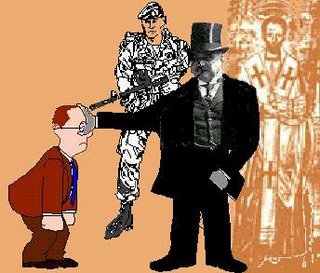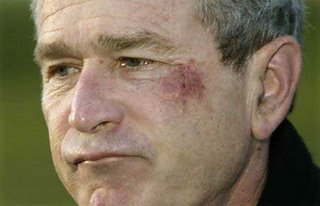The American Nightmare Realized
 In 1921, the U.S. Interior Department rigged the leasing of California's Elk Hills and Wyoming's Teapot Dome naval oil reserves after Interior Secretary Albert B. Fall received "loans" from oilmen Edward L. Doheny and Harry Sinclair. The loans of cash and stock were in the $400,000 range, with a "gift" of $100,000 from Doheny.
In 1921, the U.S. Interior Department rigged the leasing of California's Elk Hills and Wyoming's Teapot Dome naval oil reserves after Interior Secretary Albert B. Fall received "loans" from oilmen Edward L. Doheny and Harry Sinclair. The loans of cash and stock were in the $400,000 range, with a "gift" of $100,000 from Doheny.Both Teapot and Enron involved energy policy, privatization and corruption. And like Teapot Dome's "Ohio gang" of ethically loose Harding cronies, oilmen and administration officials--energy deregulation during the first Bush administration, through the Clinton years and George W.'s time as governor of Texas on up till today has been warped and feasted upon by a Texas-led "Enron gang." In both scandals, some Democrats were involved, but the power centers of misbehavior were Republican.
 Yet, there has been nothing quite like the rise and fall of Enron in U.S. history, certainly no plausible comparison since the late- 19th-century heyday of railroads and robber barons. The sums in Enron's collapse certainly overshadow those in Teapot, much as a space shuttle does a Model T Ford. More important, not in memory has a single major company grown so big in tandem with a presidential dynasty and a corrupted political system. Indeed, the Bush family has been a prominent and well-rewarded rung in Enron's climb to national political influence.
Yet, there has been nothing quite like the rise and fall of Enron in U.S. history, certainly no plausible comparison since the late- 19th-century heyday of railroads and robber barons. The sums in Enron's collapse certainly overshadow those in Teapot, much as a space shuttle does a Model T Ford. More important, not in memory has a single major company grown so big in tandem with a presidential dynasty and a corrupted political system. Indeed, the Bush family has been a prominent and well-rewarded rung in Enron's climb to national political influence.
In retrospect, it's unclear whether the Bush dynasty built Enron or vice versa. In 1985, when Enron was formed, the Bushes were an important political family. George Bush, as vice president, headed the Reagan administration's task force on energy policy. But in terms of Texas oil money and stature, the Bushes were third echelon. When George W. ran for governor of Texas in 1994, Ann Richards, the Democratic incumbent, joked that of the oil companies he had started or been involved with, none had made a profit. Enron's rise, with the Bush family's help, in the 1990s rearranged the energy power structure in Texas and the nation, and put the Bush entourage in clover. The question now is whether what went up together will come down together.

As early as 1988, when his father was president-elect, George W. Bush lobbied the Argentine government on behalf of an Enron pipeline proposal. Bush, through his staff, has denied making a telephone call on Enron's behalf, but Rodolfo Terragno, the Argentine minister of public works and services at the time, insists he did. When newly elected President Carlos Menem made a sweetheart deal with Enron, freeing the corporation of certain Argentine tariffs and taxes when doing business in the country, lawmakers demanded an investigation, and a special prosecutor undertook the task. But since his Justice Department was already "investigating," Menem fired the prosecutor.

...
From 1988 to 1992, Bush the elder collected hefty political contributions from Enron. When president, it was his ambassador in Buenos Aires who had pushed for favorable tax treatment for Enron in Argentina. Bush asked Enron chief Kenneth L. Lay to co-chair a host committee for the July 1990 G-7 economic summit in Houston and appointed him to his Export Council in late 1990. A year earlier, Bush energy officials began work on the 1992 Energy Policy Act. Its provisions obliged utility companies to carry and transmit Enron- generated electricity, which contributed to the company's subsequent huge growth. In 1992, Lay was named co-chairman of the Bush reelection campaign and chairman of the host committee of the Republican National Convention in Houston.
..much, much more at: http://www.topplebush.com/article1_busdeal.shtml
The Company Presidency; Enron and the Bush family have boosted each other up the ladder of success. But have their ties created a Teapot Dome?
From: The Los Angeles Times; Los Angeles, Calif.; Feb 10, 2002; KEVIN PHILLIPS
...
Kinda makes one wonder if ol Kenny boy Lay is on a ranch in Paraguay.


0 Comments:
Post a Comment
<< Home